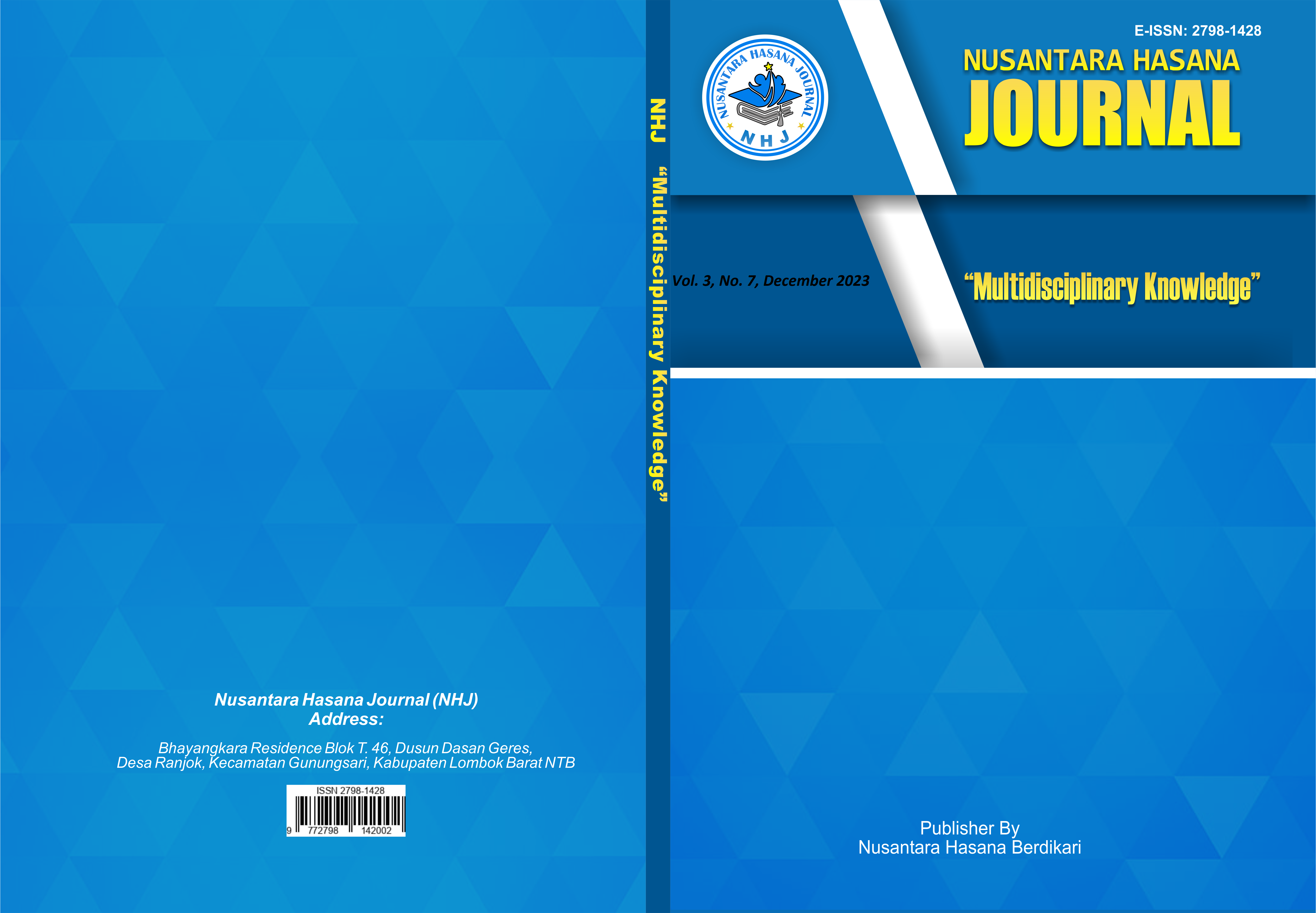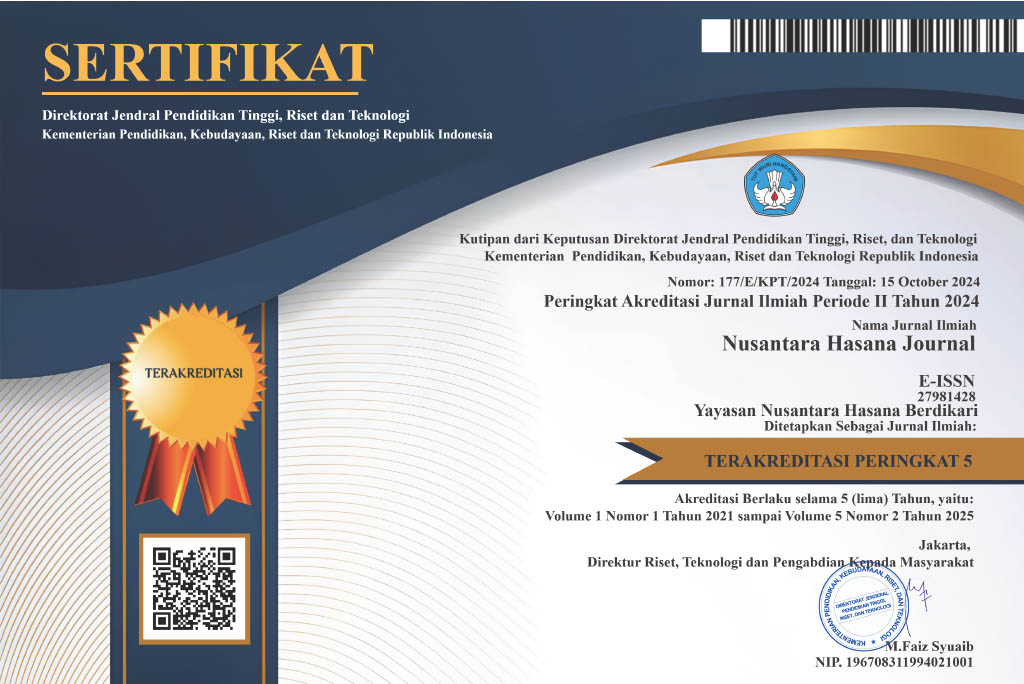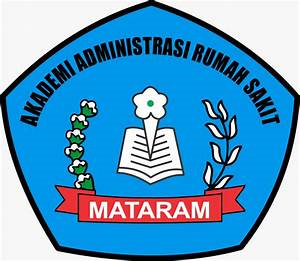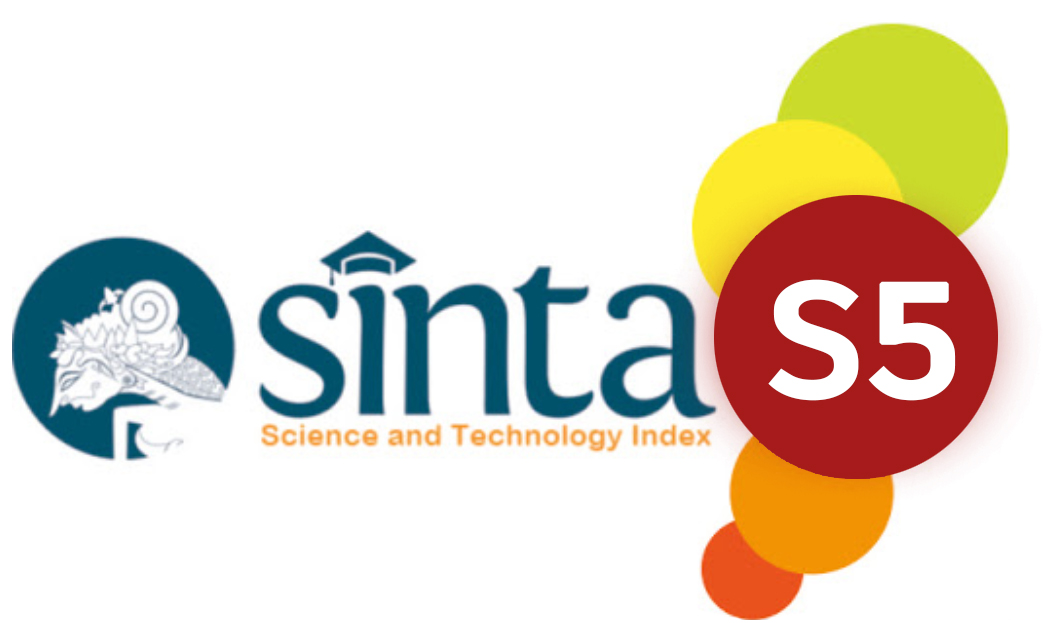HUBUNGAN HYGIENE DAN SANITASI LINGKUNGAN DENGAN KEJADIAN STUNTING PADA BALITA DI WILAYAH PUSKESMAS DADOK TUNGGUL HITAM TAHUN 2021
DOI:
https://doi.org/10.59003/nhj.v3i7.1294Keywords:
age, gender, stunting, hygiene and sanitation, toddlersAbstract
Stunting is a chronic nutritional problem in toddlers characterized by the height of children who are shorter than children of the same age. Stunting in children is a serious problem, because it is associated with the risk of greater morbidity and mortality, obesity and non-communicable diseases in the future, short adults, poor cognitive development, and low productivity and income. The aim of the study to determine the relationship between hygiene and environmental sanitation with the incidence of stunting in toddlers in the Dadok Tunggul Hitam Community Health Center in 2021. Methods using a correlative analytic study with a cross-sectional approach. The sample was selected using a total sampling technique of 55 toddlers representing all toddlers recorded at the Dadok Tunggul Hitam Puskesmas, Koto Tangah District, Padang City in 2021. This research was conducted from April 2020 to February 2021. Univariate data analysis was presented in the form of frequency and percentage distributions and bivariate analysis using the chi-square test and data processing using the computerized SPSS version 16.0 program. The most toddlers in the Dadok Tunggul Hitam Puskesmas area in 2021 aged> 36 months were 27 people (49.1%), the most under-five in the Dadok Tunggul Hitam Puskesmas area in 2021 were female 30 people (54.5%), more than half of toddlers in the Dadok Tunggul Hitam Health Center Area in 2021 did not experience stunting, namely 42 people (76.4%), more than half of children under five in the Dadok Tunggul Hitam Health Center Area in 2021 has a status of healthy environmental hygiene and sanitation, namely 37 people (67.3%), and there is a relationship between hygiene and environmental sanitation with the incidence of stunting in children under five in the Dadok Tunggul Hitam Community Health Center in 2021 (p = 0.000). It is proven that there is a relationship between hygiene and environmental sanitation with the incidence of stunting in children under five in the Dadok Tunggul Hitam Community Health Center in 2021.
Downloads
References
Pusat Data dan Informasi, Kementerian Kesehatan Republik Indonesia. 2019. Hasil Estimasi Data Penduduk Sasaran Program Pembangunan Kesehatan Tahun 2015-2019 (Diolah dari Sensus Penduduk 2010).
Dinas Pemberdayaan Perempuan dan Perlindungan Anak Provinsi Sumatera Barat tahun 2017.
Badan Pusat Statistik Kota Padang tahun 2017.
Data dari Puskesmas Dadok Tunggul Hitam. 2020.
Kementerian Kesehatan Republik Indonesia. 2018. Situasi Balita Pendek Stunting di Indonesia. Pusat Data dan Informasi Kementerian Kesehatan Republik Indonesia. Jakarta.
Margawati A M. 2018. Pengetahuan Ibu, Pola Makan dan Status Gizi Pada Anak Stunting Usia 1-5 Tahun di Kelurahan Bangetayu, Kecamatan Genuk, Semarang. Jurnal Gizi Indonesia, 62: 82.
United Nations Children's Fund. 2009. Tracking Progress On Child and Maternal Nutrition a Survival and Development Priority. New York. USA.
United Nations Children's Fund. 2007. Women and Children The Double Dividend of Gender Equality New York. USA.
Departemen Kesehatan Republik Indonesia. 2004. Higiene Sanitasi Makanan dan Minuman. Dirjen PPM dan PL. Jakarta.
United Nations Children's Fund. 2014. The State of The World‟s Children 2014 in Numbers. Everychild Counts: Revealing Disparities, Advancing Children‟s Rights. New York. USA.
Kementerian Kesehatan Republik Indonesia. 2015. Pusat Data dan Informasi Kementerian Kesehatan Republik Indonesia. Jakarta.
Badan Penelitian Dan Pengembangan Kesehatan Kementrian Kesehatan RI. 2010. Riset Kesehatan Dasar. Jakarta.
Kementerian Kesehatan Republik Indonesia. 2018. Pusat Data dan Informasi. Kemenkes RI. Jakarta.
Dinas Kesehatan. 2015. Profil Kesehatan Kota Padang. Dinas Kesehatan Kota Padang.
Zairinayati RP. 2019. Hubungan Hygiene Sanitasi dan Lingkungan dengan Kejadian Stunting Pada Balita. J Ilm Multi Sci Kesehat., 10 (1): 78-91.
Setiawan E, Machmud R, Masrul M. 2018. Faktor-Faktor yang Berhubungan dengan Kejadian Stunting pada Anak Usia 24-59 Bulan di Wilayah Kerja Puskesmas Andalas Kecamatan Padang Timur Kota Padang Tahun 2018. J Kesehat Andalas, 7 (2): 275.
Wirandoko HI. 2007. Determinan Status Gizi Anak Usia 2-5 Tahun Di Puskesmas Tlogosari Wetan, Kecamatan Pedurungan, Semarang. Tesis. Semarang: Universitas Diponegoro.
Larasati NN. 2018. Faktor-Faktor yang Berhubungan dengan Kejadian Stunting Pada Balita Usia 25-59 bulan di Posyandu Wilayah Puskesmas Wonosari II Tahun 2017. Skripsi.
Hasanah Z. 2018. Stunting Pada Balita Di Wilayah Kerja Puskesmas Kotagede I Stunting Pada Balita Di Wilayah.
Wulandari WW, Rahayu FD. 2019. Hubungan Sanitasi Lingkungan Dan Riwayat Penyakit Infeksi Dengan Kejadian Stunting di Wilayah Kerja Puskesmas Kerkap Kabupaten Bengkulu Utara Tahun 2019. Avicenna J Ilm., 14 (02): 6-13.
Rahayu, Leni. 2012. Hubungan Pendidikan Orang Tua Dengan Perubahan Status Stunting Dari Usia 6-12 Bulan Ke Usia 3-4 Tahun.
Aisah S, Ngaisyah RD, Rahmuniyati ME. 2019. Personal Hygiene Dan Sanitasi Lingkungan Berhubungan dengan Kejadian Stunting di Desa Wukirsari Kecamatan Cangkringan. Pros Semin Nas Multidisiplin Ilmu, 1 (2): 49-55.
Dewi I.A., Kadek Tresna A. 2016. Pengaruh Konsumsi Protein dan Seng serta Riwayat Penyakit Infeksi terhadap Kejadian Stunting pada Anak Balita Umur 24-59 Bulan Di Wilayah Kerja Puskesmas Nusa Penida III. Jurnal Gizi dan Pangan, 3 (1): 36-46.
Desyanti, Chamilia; Nindya TS. 2017. Hubungan Riwayat Penyakit Diare dan Praktik Higiene dengan Kejadian Stunting pada Balita Usia 24-59 Bulan di Wilayah Kerja Puskesmas Simolawang, Surabaya. Amerta Nutr: 243-251.
Atikah, Laily K. 2014. Risiko Pendidikan Ibu terhadap Kejadian Stunting Pada Anak 6-23 Bulan. Jurnal Penel Gizi Makan, 37.
Laily I, Andarmoyo S. 2012. Personal Hygiene: Konsep, Proses, dan Aplikasi Praktik Keperawatan. Yogyakarta: Graha Ilmu.
Kementerian Kesehatan Republik Indonesia. 2016. Profil Kesehatan Indonesia 2015. Jakarta.
Tasnim T, Dasvarma G, Mwanri L. 2017. Housing conditions contribute to underweight in children: An example from rural villages in southeast Sulawesi, Indonesia. J Prev Med Public Heal, 50 (5): 328-335.
Maghafirah M. Sukismanto. Rahmuniyati ME. 2018. Hygiene Sanitasi Penjamah Makanan Di Sepanjang Jalan Raya Tajem Maguwoharjo Yogyakarta Tahun 2017, 3: 15-22.
Larsen DA, Grisham T, Slawsky E, Narine L. 2017. An individual-level meta-analysis assessing the impact of community-level sanitation access on child stunting, anemia, and diarrhea: Evidence from DHS and MICS surveys. PLoS Negl Trop Dis, 11 (6).
Downloads
Published
How to Cite
Issue
Section
License
Copyright (c) 2023 Laura Zeffira

This work is licensed under a Creative Commons Attribution-NonCommercial-ShareAlike 4.0 International License.
NHJ is licensed under a Creative Commons Attribution-NonCommercial-ShareAlike 4.0 International License.
Articles in this journal are Open Access articles published under the Creative Commons CC BY-NC-SA License This license permits use, distribution and reproduction in any medium for non-commercial purposes only, provided the original work and source is properly cited.
Any derivative of the original must be distributed under the same license as the original.
























